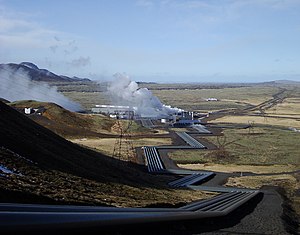| This article's factual accuracy may be compromised due to out-of-date information. Please help update this article to reflect recent events or newly available information. (April 2013) |
| Hellisheiði Power Station | |
|---|---|
 | |
| Country | Iceland |
| Location | Hengill |
| Coordinates | 64°02′14″N 21°24′03″W / 64.03722°N 21.40083°W / 64.03722; -21.40083 |
| Status | Operational |
| Commission date | 2006 |
| Owner | ON Power |
| Geothermal power station | |
| Type | Flash steam |
| Wells | 50 |
| Max. well depth | 2,200 m (7,200 ft) |
| Cogeneration? | Yes |
| Thermal capacity | 200 MWt |
| Power generation | |
| Units operational | 6 x 45 MW 1 x 33 MW |
| Nameplate capacity | 303 MW |
| External links | |
| Website | www |
| Commons | Related media on Commons |
| [edit on Wikidata] | |
The Hellisheiði Power Station (Icelandic: Hellisheiðarvirkjun, Icelandic pronunciation: [ˈhɛtlɪsˌheiːðarˌvɪr̥cʏn]) is the eighth-largest geothermal power station in the world and largest in Iceland. The facility is located in Hengill, southwest Iceland, 11 km (7 mi) from the Nesjavellir Geothermal Power Station. The plant has a capacity of 303 MW of electricity and 200 MWth of hot water for Reykjavík's district heating. The power station is owned and operated by ON Power, a subsidiary of Reykjavík Energy.
History

Electricity production with two 45 MW turbines commenced in 2006. In 2007, an additional low pressure steam turbine of 33 MW was added. In 2008, two 45 MW turbines were added with steam from Skarðsmýrarfjall Mountain. The hot water plant was introduced in 2010 and the last two high pressure 45 MW turbines were added in 2011. In order to reduce hydrogen sulphide pollution in the capital area a system was added to the plant in 2014 which reinjects non-condensable gases into the ground. In 2020, the hot water production was increased to 200 MWth to meet the increased district heating demand as the capital area expands.
Renewed drilling
In 2016 the operator, ON, announced a program of new drilling to deal with falling steam levels which had first become apparent in 2013. The program was expected in 2017 to cost 19 billion Icelandic crowns to maintain a steady electric output.
Features

The power plant offers educational tours and presentations about sustainable energy as part of its Geothermal Energy Exhibition.
A pilot direct air capture facility operated by Climeworks is co-located at this site. It was partially funded by the European Union's Horizon 2020 program, and captures up to 4000 metric tons of carbon dioxide each year. The carbon dioxide is captured, injected into the ground, and mineralized.
See also
- Geothermal power in Iceland
- List of largest power stations in the world
- List of power stations in Iceland
- Renewable energy in Iceland
- CarbFix
References
- "Profiling the six major geothermal power plants across Iceland". Retrieved 2022-07-08.
- "Hellisheidi Geothermal Power Plant Engineers - Mannvit - Mannvit". Mannvit. Archived from the original on 2009-05-30. Retrieved 2010-01-02.
- "Sustainable energy: inside Iceland's geothermal power plant". the Guardian. 29 May 2016. Retrieved 8 September 2016.
- "Mengun dælt í iður jarðar". 8 October 2014.
- "Expansion Hellisheidi geothermal plant". Mannvit. Retrieved 2024-01-16.
- "Serious geothermal troubles for Reykjavík Energy". 24 February 2017.
- "The Geothermal Energy Exhibition". Retrieved 9 November 2015.
- "Climeworks and CarbFix2: The world's first carbon removal solution through direct air capture | Climeworks – Capturing CO2 from Air". Retrieved 2019-12-22.
- Rathi, Akshat (12 October 2017). "World's first "negative emissions" plant turns carbon dioxide into stone". Quartz. Retrieved 2019-12-22.
- "Plans to double CarbFix reinjection at the Hengill Geothermal Area". Carbfix. 2019-11-20. Retrieved 2019-12-24.
External links
![]() Media related to Hellisheiði Geothermal Plant at Wikimedia Commons
Media related to Hellisheiði Geothermal Plant at Wikimedia Commons
- Hellisheiði Power Plant 2006-10-21 - Picture gallery from islandsmyndir.is
- Hellisheiði Power Plant 2008-11-15 - Picture gallery from islandsmyndir.is
- Hellisheiði Power Plant 2009-10-04 - Picture gallery from islandsmyndir.is
- Hellisheiði Power Plant, Inside 2012-04-27 - Picture gallery from islandsmyndir.is
- Hellisheiði Power Plant, Outside 2012-05-09 - Picture gallery from islandsmyndir.is